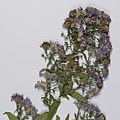Symphyotrichum laeve
| Symphyotrichum laeve | |
|---|---|

| |
| Scientific classification | |
| Kingdom: | Plantae |
| Clade: | Tracheophytes |
| Clade: | Angiosperms |
| Clade: | Eudicots |
| Clade: | Asterids |
| Order: | Asterales |
| Family: | Asteraceae |
| Tribe: | Astereae |
| Subtribe: | Symphyotrichinae |
| Genus: | Symphyotrichum |
| Subgenus: | Symphyotrichum subg. Symphyotrichum |
| Section: | Symphyotrichum sect. Symphyotrichum |
| Species: | S. laeve
|
| Binomial name | |
| Symphyotrichum laeve | |
| Varieties[2] | |

| |
| North American distribution[2][3][4] | |
| Synonyms[2] | |
|
Basionym
Alphabetical list
| |
Symphyotrichum laeve (formerly Aster laevis) is a flowering plant native to Canada, the United States, and Coahuila (Mexico). It has the common names of smooth blue aster,[5] smooth aster,[4] smooth-leaved aster, glaucous Michaelmas-daisy[6] and glaucous aster.[4]
Description
[edit]Smooth aster is 20 to 70 centimeters (8 to 28 inches) tall.[7] Its leaves are arranged alternately on the stems, and their shape varies among lanceolate, oblong-ovate, oblong-obovate, and ovate.[8] They measure from 3 to 20 centimeters (1 to 8 inches) long and from 1 to 2.5 cm (3⁄8 to 1 in) wide. They are usually hairless, and the leaf edges are entire or bluntly or sharply toothed (crenate or serrate), sometimes with smaller teeth (serrulate).[7]
The flower heads are arranged in clusters (panicles). Each flower head has 13 to 23 ray florets with pale to dark blue or purple petals (laminae), and 19 to 33 disc florets that start out yellow and eventually turn purplish-red.[7] The whole flowerhead measures 13 to 25 millimeters (1⁄2 to 1 in) across.[8]
The seeds are cypselae with pappi (bristles at their tips).[7] Like the hairs on dandelion seeds, the pappi allow the seeds to be spread by the wind.[8]
Taxonomy
[edit]There are four varieties: Symphyotrichum laeve var. laeve, S. laeve var. geyeri (Geyer's aster[3]), S. laeve var. concinnum, and S. laeve var. purpuratum.[7]
Hybrids with this species and others of the genus have been reported, including three named as follows:[9]
- Symphyotrichum × gravesii between S. laeve var. laeve and S. dumosum;
- Symphyotrichum × versicolor between S. laeve var. laeve and S. novi-belgii var. novi-belgii; and,
- Symphyotrichum × woldenii between S. laeve var. laeve and S. praealtum, which instead may be between S. oolentangiense and S. praealtum.
-
Symphyotrichum × gravesii
-
Symphyotrichum × versicolor
-
Symphyotrichum × woldenii
-
Symphyotrichum subg. Chapmaniana[ref 2]: 133subg. Astropolium[ref 2]: 133subg. Virgulus[ref 1]: 272subg. Symphyotrichum[ref 1]: 267sect. Conyzopsis[ref 1]: 271sect. Occidentales[ref 1]: 271sect. Turbinelli[ref 2]: 133sect. Symphyotrichum[ref 1]: 268Cladogram references
- ^ a b c d e f g h i j k l m n o Nesom, G.L. (September 1994). "Review of the Taxonomy of Aster sensu lato (Asteraceae: Astereae), Emphasizing the New World Species". Phytologia. 77 (3) (published 31 January 1995): 141–297. ISSN 0031-9430. Retrieved 23 August 2021 – via Biodiversity Heritage Library.
- ^ a b c d e f g h i Semple, J.C.; Heard, S.B.; Brouillet, L. (2002). "Cultivated and Native Asters of Ontario (Compositae: Astereae)". University of Waterloo Biology Series. 41. Ontario: University of Waterloo: 1–134.
- ^ Sugbenus Ascendentes is made up of two allopolyploid species with historic parents from subg. Virgulus and subg. Symphyotrichum.
Distribution and habitat
[edit]Symphyotrichum laeve varieties are native to Canada, the United States,[2] and Coahuila (Mexico).[3] The species is introduced in Québec and New Brunswick.[4]
S. laeve grows in fields, open woods, and along roadsides[10] in rocky or dry soil and full sun.[11]
Ecology
[edit]Symphyotrichum laeve blooms in late summer and early fall. It is pollinated by many native bees[10] and attracts butterflies.[11] It is a larval host for the pearl crescent butterfly (Phyciodes tharos).[12][8]
Conservation
[edit]Citations
[edit]- ^ NatureServe 2021.
- ^ a b c d e POWO 2019.
- ^ a b c Brouillet et al. 2006, var. geyeri.
- ^ a b c d Brouillet et al. 2020.
- ^ USDA 2014.
- ^ BSBI 2007.
- ^ a b c d e Brouillet et al. 2006.
- ^ a b c d Hilty 2016.
- ^ Brouillet et al. 2006, var. laeve.
- ^ a b TWC Staff 2017.
- ^ a b Missouri Botanical Garden n.d.
- ^ Evergreen 2014.
References
[edit]- Brouillet, L.; Desmet, P.; Coursol, F.; Meades, S.J.; Favreau, M.; Anions, M.; Bélisle, P.; Gendreau, C.; Shorthouse, D. (4 September 2020). "Symphyotrichum laeve (Linnaeus) Á. Löve & D. Löve". data.canadensys.net. Database of Vascular Plants of Canada (VASCAN). Retrieved 14 September 2021.
- Brouillet, L.; Semple, J.C.; Allen, G.A.; Chambers, K.L.; Sundberg, S.D. (2006). "Symphyotrichum laeve". In Flora of North America Editorial Committee (ed.). Flora of North America North of Mexico (FNA). Vol. 20. New York and Oxford: Oxford University Press. Retrieved 14 September 2021 – via eFloras.org, Missouri Botanical Garden, St. Louis, MO & Harvard University Herbaria, Cambridge, MA.
- BSBI List 2007 (xls). Botanical Society of Britain and Ireland. Archived from the original (xls) on 26 June 2015. Retrieved 17 October 2014.
- Evergreen (2014). "Plant Detail: Symphyotrichum laeve (smooth blue aster, smooth aster)". Native Plant Database (nativeplants.evergreen.ca). Toronto, Ontario: Evergreen. Archived from the original on 2 February 2017. Retrieved 27 January 2017.
- Hilty, J. (2016). "Smooth Blue Aster (Symphyotrichum laeve)". Illinois Wildflowers (www.illinoiswildflowers.info). Retrieved 30 September 2016.
- Missouri Botanical Garden (n.d.). "Symphyotrichum laeve - Missouri Botanical Garden Plant Finder". www.missouribotanicalgarden.org. St. Louis. Retrieved 27 January 2017.
{{cite web}}: CS1 maint: year (link) - NatureServe (2 July 2021). "Symphyotrichum laeve Smooth Blue Aster". explorer.natureserve.org. Arlington, Virginia. Retrieved 17 July 2021.
- POWO (2019). "Symphyotrichum laeve (L.) Á.Löve & D.Löve". powo.science.kew.org. Royal Botanic Gardens, Kew. Retrieved 17 July 2021.
- TWC Staff (2017). "Symphyotrichum laeve". Lady Bird Johnson Wildflower Center (www.wildflower.org). University of Texas at Austin. Retrieved 27 January 2017.
- NRCS (2014). "Symphyotrichum laeve". PLANTS Database. United States Department of Agriculture (USDA). Retrieved 6 December 2015.










